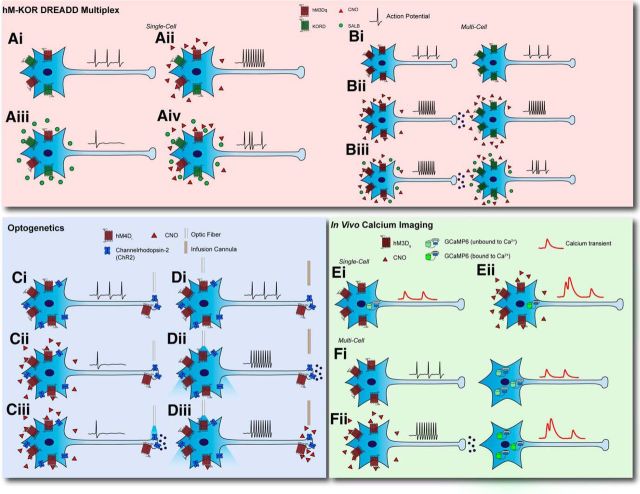Figure 2.
DREADD multiplexing opportunities. A, Excitatory hM DREADDs can be expressed with inhibitory KOR DREADDs in the same cell type (Ai). Administering CNO will increase activity in these cells (Aii) while SalB administration will decrease activity (Aiii). Coadministration will produce an occlusion of excitation and inhibition, producing blunted change in neural activity (Aiv). B, Alternatively, excitatory hM DREADD can be expressed upstream of a presumptively connected circuit while KOR DREADDs are expressed postsynaptically. In this example, the presynaptic neurons are excitatory (Bi). Administration of CNO will increase activity both in the hM-expressing population and the presumptive downstream population (Bii), while coadministration of both ligands will occlude the presynaptic excitatory drive from the CNO-expressing population (Biii). C, D, Likewise, opsins and DREADDs can also be expressed in the same cell population. For example, inhibitory DREADD and channelrhodopsin-2 can be expressed in one population, and an optic fiber can be positioned over a specific terminal field (Ci) or over the cell body with an infusion cannula at a specific terminal field (Di). Systemic CNO administration will decrease cell firing rate (Cii), but optogenetic terminal stimulation can elicit synaptic release despite broader hyperpolarization of the cell (Ciii). On the other hand, optogenetic soma stimulation will increase cell activity (Dii), but this can be occluded using cannulated infusion of CNO at terminal fields (Diii). E, F, To monitor cell activity changes in real time, DREADDs can also be multiplexed with fluorophores such as GCaMP. These can be expressed in the same cell (Ei) or expressed in series (Fi). Systemic administration of CNO can activate DREADDs, producing a change in intracellular calcium, thus altering GCaMP signals; for example, excitatory DREADD activation produces large increases in calcium activity (Eii). Moreover, when excitatory DREADD is expressed in presynaptic populations and GCaMP is expressed in a postsynaptic population, systemic CNO administration would produce increases in calcium activity in the postsynaptic cell, leading to an increased GCaMP signal (Fii).

